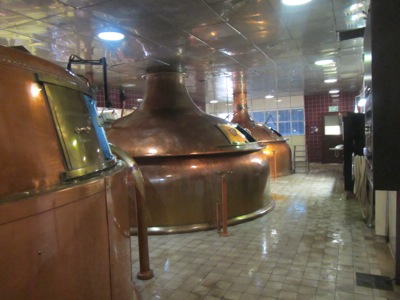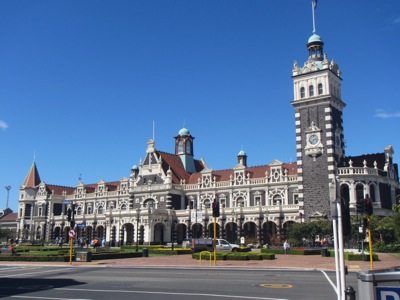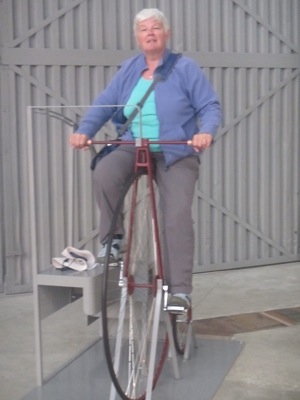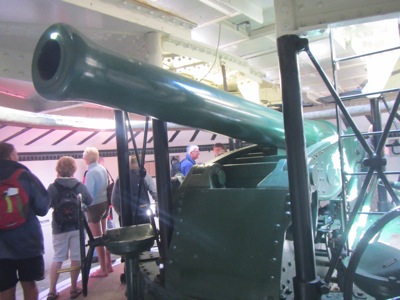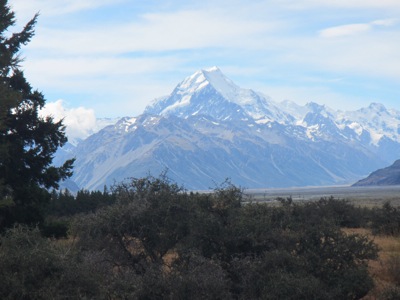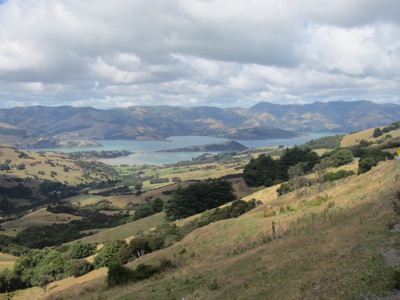South Island - Week 4

Scott-Free’s blog
Steve & Chris
Sat 1 Mar 2014 22:08
Left Porpoise Bay to head northward through the Catlins, with the intention of stopping at various places along the way and arriving at Cathedral Caves around 2 p.m. This would coincide with the state of the tide allowing access along the beach to the tall, arched caves. The weather, however, had other plans and was being particularly unpleasant, very wet and very windy. We stopped at McLean Falls and made the hour round-trip walk through the woods to the waterfall without getting too wet as the trees kept most of the wind and rain at bay. The falls were well worth the effort.
The rest of our planned stops had to be abandoned though, as the weather would not relent, and we drove on through to Dunedin. We checked into Leith Valley Holiday Park where our cabin fortunately had a heater, and spent an hour or two warming up and drying out. When the rain relented a little later, we ventured out for a drive through the town and stopped for a fish and chips supper. The fish was gurnard, which neither of us had tried before. Pleasant enough, but with a very mild flavour, it doesn't go high on the list.
Monday 24th February
First on the list today was a tour of Speight's brewery which has been brewing beer on this site since the 1800's. We were a little disappointed to find that production had stopped on the old equipment only recently and a modern brew house next door had taken over. In fact, they were cleaning up the 'heritage site' for the Prime Minister's visit the following day to officially open the new brew house. The upside was that we got to see close up the old copper equipment, but the downside was that it was all a little sterile. We'd been looking forward to the smell of hops and yeast and all those brewing smells. The tour ended with half an hour in the tasting room where six different beers and a cider were on tap on a help yourself basis. So not too disappointing...
We stopped for lunch at a little Thai restaurant nearby, and then walked down to the Railway Station which is reputedly one of the best examples of railway architecture in the Southern Hemisphere. Opened in 1906, Flemish Renaissance style building, a treat to look at inside and out. Then on to the Otago Settlers Museum which has excellent displays tracing the history of human settlement in the Otago Peninsula. We found this so interesting that we were still there at closing time, and decided we would return the next day to finish.
Tuesday 25th February
Started the day with a visit to Olveston House, a 35-room Jacobean-style mansion built in 1906 from parts shipped from England and Australia. It was left to the city by the last remaining child of the Theomin family it was built for and it remains pretty much as it was when the family lived in it. An interesting hour spent touring the house with an informative guide.
Next stop - a dentist. My toothache had returned a few days ago and was getting gradually worse, so time to get it looked at. A rather unpleasant hour in the chair revealed and dealt with the culprit, a gap under a gold inlay had allowed bugs to get into the tooth and decay to set in. So the inlay had to come off, the decay drilled out and a temporary filling put in the tooth until I can get it looked at by my own dentist back home. Sorted. For now.
Didn't feel much like lunch, but we stopped at an Indian restaurant doing a $10 lunch deal, and it was a good call because the chicken curry and rice were easy to manage with half my mouth still numb. Then back to the Otago Settlers Museum to see what we didn't have time for yesterday. The Chinese Garden was next, not much to see so didn't take long. Last job of the day to find a doctor to write Steve a prescription for some more daily meds. The walk-in medical centre wanted $150 (£75) just to see him. We walked back out. The friendly doctor along the road was happy to see him and gave him a 6-month prescription for a fee of $40 (£20).
Wednesday 26th February
Left Dunedin and drove to the Otago Peninsula. The road out to the end of the peninsula runs along the coast and the views were quite beautiful. We reached the Royal Albatross Centre just before lunchtime and got tickets for the 2 p.m. tour. The nesting birds can only be seen from a special observatory on the hillside which can only be accessed with a guide. This is to protect the colony. So we spent some time looking at the displays in the centre, then had a picnic lunch in the car overlooking the bay, and returned in time for the tour.
There were five nests, four of which had a parent sitting on a chick, and the fifth had an chick which was old enough to be left 'home alone' while the parents went out getting food for it. By the time the chick fledges, it will weigh more than the adults. We also saw some adult birds soaring in the strong winds off the cliffs.
The hillside used to be a lookout point during the wars, and the guide then took us down inside the hill to show us the Armstrong disappearing gun. Installed in 1886 after a Russian warship appeared off the NZ coast armed with more cannon than they had in the whole of New Zealand, it was designed to 'pop up' out of the ground, fire, and then recoil back into its pit. It's the only one of its kind in the world still in working order and in its original position. Fascinating (yawn...)
Tour over, we headed off the Otago peninsula and northwards towards Oamaru, our stop for the night. On the way we stopped to look at the Moeraki boulders - large rounded rocks on the beach. Apparently formed on the seabed 60 million years ago, it is not known why or how they ended up here. A nice stroll along the beach to take a look at them, laugh at Steve as he tried to climb on top of one and failed miserably while an agile young man did it in one leap, stroll back to the car and head to the camp at Waitaki Beach for the night.
Thursday 27th February
Set off on the long drive to Aoraki/Mount Cook National Park. It was a beautiful, sunny, clear day and we had spectacular views of the mountain as we drove towards it. Along the way we took a 20km scenic detour over a dam and around the shores of Lake Aviemore. We were impressed to see three large dams supporting hydroelectric power production in this area. We were also a little surprised to notice that many of the broad-leaved trees were turning shades of yellow, red, orange, and realised that autumn is not too far away.
We had booked a room at the Glentanner Park, about 20kms from Mount Cook Village, as the rooms in the village were rather expensive. We hoped we would have some view of the mountain, so were overjoyed to find that we had the most awesome view right through the glass-doored front of the cabin to the snow-covered peak!
After dumping our stuff inside, we set off again the final 20kms to the village, 700 or so metres above sea level, and 3000 metres below the summit of Aoraki/Mount Cook. We drove around the village and made the Sir Edmund Hillary Alpine Centre our first stop. We spent an hour looking at the exhibits of his exploits and decided to return the next morning.
Back at the lodge we went for an early evening stroll towards the lake, and then enjoyed dinner looking out at the mountain. The evening was so clear that we could see it right until the last bit of light disappeared. Magic.
Friday 28th February
When we woke this morning all we could see were clouds! But we'd had such magnificent views the whole day before that we didn't really mind. We headed back up to Mount Cook Village and returned to see the rest of the displays and documentaries about Mount Cook and then of Hillary conquering Everest. We later went to the visitor centre and browsed the displays there, before setting off back down the mountain road.
We stopped for lunch on the shores of Lake Pukaki, where, on a clear day you can see the mountain rising up behind. Today there were just clouds. We sat in the car to eat lunch as it was so windy and cold, and then made our way to Timaru for tonight's stop. When driving through the town, we spotted a Kathmandu, so stopped and bought ourselves a pair of long trousers each. They say autumn begins on the 1st March in the South Island and they are not wrong!
Saturday 1st March
Today dawned sunny and clear again, and we set off for the drive along the state highway to the Banks Peninsula, just east of Christchurch, expecting the first stretch to be a pretty boring drive. But before we had even left the town, as we crowned a hill, a most spectacular vista opened before us of the Southern Alps in all their glory, and we were quite honestly speechless. We have seen some wonderful views during our six year trip, but I don't remember saying 'wow' so much or so often. The Southern Alps are simply breathtakingly awesome. No photo can convey it, you have to see it for yourself. We are so lucky.
Because of the low plains that seem to spread right across from the eastern coast to the alps, it is possible to see the mountain range continuously as you drive the main highway. Eventually we came to the outskirts of Christchurch and turned right towards the Banks Peninsula. The road took us across flat land and then climbed steeply upwards on the rocky peninsula that was once an Island but joined the mainland after a volcanic eruption 25,000 years ago. Quite recently then.
From the road at the summit we could see right down into the long harbour of Akaroa where we would be staying for a couple of days.
Sent from my iPad

